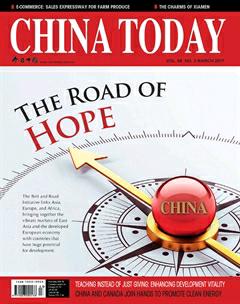Economy
Extensive Agricultural Sector Reform Imminent
China will develop the agricultural sector through deepened supplyside structural reforms, according to a policy document released in early February by the CPC Central Committee and the State Council.
Structural problems on the supply side constitute the major obstacles facing Chinas agricultural sector, the document said.
The document calls for improved industry structures and increased output of high-quality products based on green and innovative production. It also proposes extending the sectors industrial and value chain, consolidating shared rural development, and enhancing rural reforms.
National grain security must be guaranteed when carrying forward supply-side structural reforms to the sector, the document said. With an output of about 616 million tonnes, Chinas grain yield dropped in 2016 by around 5.2 million tonnes, or 0.8 percent year on year, so ending a 12-year rising trend.
China started structural reforms to its agricultural sector a few years ago. They also aim to refine the system of quality supervision of farm produce, and standards of soil pollution control, and encourage agricultural businesses to gain international certification.
The country plans to promote the export of competitive farm produce, cross-border operation of agricultural enterprises, and the establishment of global leaders in the sector.
New Demonstration Zones for the Ocean Economy
China plans to establish 10 to 20 demonstration zones between 2016 and 2020 to promote the ocean economy, according to a guideline released in early 2017 by the National Development and Reform Commission (NDRC) and the State Oceanic Administration (SOA).
The zones will feature projects that advance innovative ocean economy development patterns, coordinate the development of ocean industries, and protect the marine ecosystem,
Cities that achieved more than 10 percent growth in ocean industry added value and industrial parks that achieved more than 15 percent added value in that sector the previous year will be chosen as sites on which to establish demonstration zones, according to the guidelines.
By 2020, the growth of ocean economy in these zones will be higher than that of local economic development.
The SOA and Ministry of Finance have selected eight cities and districts, including Fuzhou, Xiamen, and Qingdao, as the first batch of demonstration zones that will receive special subsidies. In these zones, industries such as seawater desalination and high-end equipment will be encouraged.
The ocean economy has become a powerful driver of the national economy. During the period of 2011-2015, the annual growth of the China Ocean Economic Development Index was 3.7 percent, implying good overall development of the ocean-based economy.
Chinese ODI Nears US $200B
Estimates show that Chinas overseas direct investment soared by 40 percent in 2016 (over that of 2015) to a record US $189 billion, according to a study released by the U.S. consultancy Rhodium Group and Berlinbased Mercatur Institute for China Studies.
Europe appeared as the key destination, the countrys EU investments having jumped 77 percent to more than €35 billion, of which Germany bagged €11 billion, or 31 percent of the total, the report said.
It highlighted the particular interest Chinese investors showed in advanced manufacturing and service sectors, citing such mega deals last year as the acquisitions of KUKA, Skyscanner, and the Odeon cinema chain.
These trends coincided with Chinas recent warnings to state-owned enterprises about outbound investments in mining and heavily polluting industries.
Chinas top state-owned assets regulator plans to improve the accountability and risk control of SOE overseas acquisitions.
Head of the National Development and Reform Commission Xu Shaoshi recently spoke of the necessity for prudent investments. He, however, added that, “overall support for Chinese firms going global has not and will not change.”
Heavy Investment in Water Conservation Projects
China will introduce 15 new major water conservation projects in 2017, amid efforts to boost investment and stabilize growth, according to National Development and Reform Commission.
Total investment in major water projects under construction is set to exceed RMB 900 billion (US $131.3 billion) by the end of this year.
So far, 106 of the 172 major water conservation projects have been launched. Total investment in ongoing projects exceeds RMB 800 billion(US $116.3 billion).
Against the backdrop of the economic “new normal,” China views infrastructure investment as a significant force towards boosting growth.
Official statistics show that Chinas fixed asset investment continued to cool in 2016, with a year-on-year growth of 8.1 percent, compared with 10 percent in 2015, and 15.7 percent in 2014. However, investment in infrastructure construction rose by 0.2 percentage points, amounting to year-on-year growth of 17.4 percent in 2016.
- CHINA TODAY的其它文章
- Sci-Tech
- The Road of Hope
- Pakistan Showcases Achievements in Belt and Road Cooperation
- Enhancing Connectivity in East Africa: The Addis Ababa-Djibouti Railway
- Building Lifelines in Tajikistan–Tebian Electric Apparatus Stock Co.
- Chinese Projects Bring New Opportunities to Aktogay in Kazakhstan

